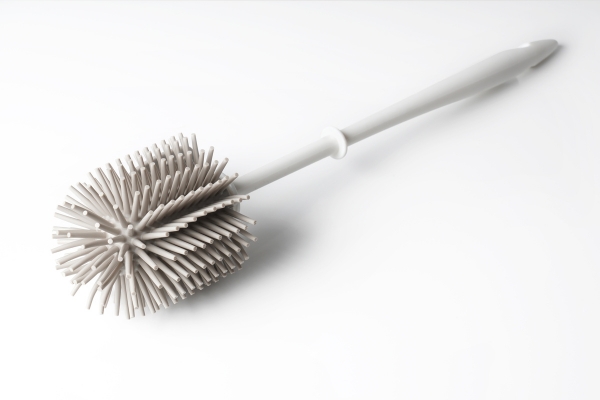Cleaning a toilet brush without bleach can be an eco-friendly and effective way to maintain hygiene in your bathroom. Many people seek alternatives to harsh chemicals for health, environmental, or safety reasons. In this guide, we’ll explore various methods using common household items to keep your toilet Scrubber clean and sanitized. From natural disinfectants like vinegar and baking soda to innovative cleaning hacks, you’ll learn how to clean a toilet brush without bleach while ensuring it remains free from harmful bacteria and unpleasant odors. By adopting these simple, bleach-free cleaning techniques, you can achieve a sparkling clean bathroom with peace of mind.
Why Avoid Bleach?
Avoiding bleach when cleaning a toilet brush is a smart choice for several reasons. First, bleach is a potent chemical that can cause skin and respiratory irritation, posing health risks to those with sensitivities or allergies. Additionally, the harsh nature of bleach can degrade the plastic and bristles of the toilet Scrubber over time, reducing its lifespan and effectiveness. Environmentally, bleach is harmful as it can contribute to water pollution, affecting aquatic life and ecosystems when it enters the water supply. By opting for alternative cleaning methods, you can maintain a hygienic bathroom while protecting your health and the environment.
Materials Needed
- Baking Soda
- Essential Oils
- Hydrogen Peroxide
- Dish Soap
- A Bucket Or Large Container
- Gloves
- Old Toothbrush Or Cleaning Brush
Step-By-Step Guide to Cleaning Your Toilet Brush
Step 1: Initial Rinse

Begin by rinsing the toilet brush thoroughly with hot water. This initial rinse helps to remove any loose debris and surface grime. Hold the Scrubber under the stream of water and rotate it to ensure all bristles are rinsed. You can also gently tap the brush against the side of the toilet bowl to dislodge any stuck-on particles. This step is crucial as it prepares the brush for a more thorough cleaning.
Step 2: Soak in Vinegar Solution

Next, prepare a cleaning solution using white vinegar. Fill a bucket or container with equal parts of white vinegar and hot water. Submerge the toilet Scrubber in this solution, ensuring that the bristles are fully covered. Allow the Scrubber to soak for at least one hour; for deeper cleaning, you can leave it overnight. The vinegar works as a natural disinfectant, killing bacteria and neutralizing odors. After soaking, give the brush a final rinse with hot water to remove any residual vinegar. This step ensures your toilet Scrubber is not only clean but also free from harmful germs without using bleach.
Step 3: Scrub with Baking Soda

After soaking the toilet brush in the vinegar solution, it’s time to scrub it with baking soda for a thorough clean. Sprinkle a generous amount of baking soda directly onto the bristles. Using a scrubbing Scrubber or an old toothbrush, work the baking soda into the bristles, scrubbing away any remaining grime and stains. The abrasive nature of baking soda helps to lift dirt and provides an extra layer of deodorization. Once you’ve scrubbed all parts of the Scrubber, rinse it thoroughly with hot water to wash away the baking soda and loosened debris.
Step 4: Use Essential Oils for Freshness

To give your toilet Scrubber a fresh scent and additional antibacterial properties, add a few drops of essential oils to the bristles. Tea tree oil, lavender, and eucalyptus oils are excellent choices due to their natural disinfectant qualities. Simply drip a few drops onto the brush and let it sit for a few minutes. The essential oils not only leave a pleasant aroma but also help in killing any remaining bacteria. This step ensures that your toilet Scrubber stays fresh and clean between uses.
Step 5: Rinse and Dry

The final step is to rinse and dry your toilet Scrubber thoroughly. Hold the brush under hot running water, rotating it to ensure all sides are rinsed clean of any residual cleaning agents and essential oils. Shake off excess water and allow the Scrubber to air dry completely before storing it. Ideally, place the brush in a well-ventilated area or hang it up to dry to prevent any moisture buildup, which can lead to mold and mildew. By ensuring the Scrubber is dry before storage, you maintain its cleanliness and extend its usability.
When to Replace Your Toilet Brush?
Knowing when to replace your toilet brush is essential for maintaining bathroom hygiene. Typically, it’s recommended to replace the Scrubber every six months to a year, depending on the frequency of use and the level of care taken in cleaning it. Signs that indicate it’s time for a new Scrubber include bristles that are frayed, discolored, or missing, as these can reduce the brush’s effectiveness in cleaning. Additionally, if you notice a persistent unpleasant odor or if the Scrubber remains visibly dirty despite thorough cleaning efforts, it’s a clear indication that replacement is necessary. Regular inspection and timely replacement of your toilet Scrubber ensure that it continues to function properly and maintain the cleanliness of your bathroom.
Conclusion
Cleaning your toilet brush Holder without bleach is not only possible but also beneficial for your health and the environment. By following simple steps like an initial rinse, soaking in a vinegar solution, scrubbing with baking soda, using essential oils for freshness, and ensuring thorough rinsing and drying, you can keep your toilet Scrubber clean and sanitary. Regular maintenance and timely replacement of the Scrubber further enhance bathroom hygiene. Embracing these eco-friendly cleaning methods helps maintain a fresh, germ-free bathroom without the need for harsh chemicals.


